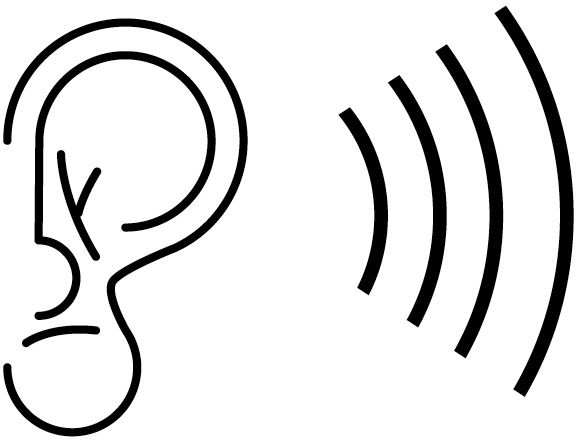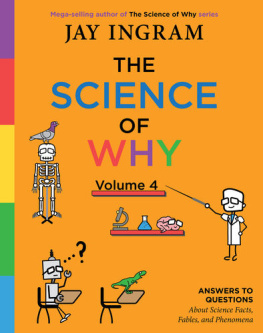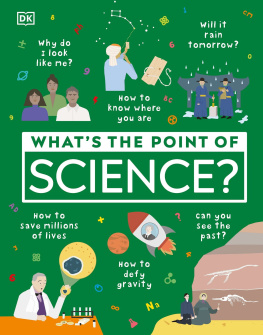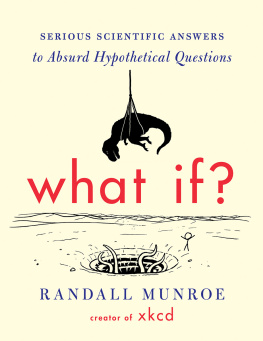ALSO BY JAY INGRAM
The Science of Why, Volume 3: Answers to Questions About Science Myths, Mysteries, and Marvels
The Science of Why2: Answers to Questions About the Universe, the Unknown, and Ourselves
The Science of Why: Answers to Questions About the World Around Us
The End of Memory: A Natural History of Aging and Alzheimers
Fatal Flaws: How a Misfolded Protein Baffled Scientists and Changed the Way We Look at the Brain
Theatre of the Mind: Raising the Curtain on Consciousness
Daily Planet: The Ultimate Book of Everyday Science
The Daily Planet Book of Cool Ideas: Global Warming and What People Are Doing About It
The Science of Everyday Life
The Velocity of Honey: And More Science of Everyday Life
The Barmaids Brain and Other Strange Tales from Science
The Burning House: Unlocking the Mysteries of the Brain
A Kids Guide to the Brain
Talk Talk Talk: Decoding the Mysteries of Speech
Its All in Your Brain
Real Live Science: Top Scientists Present Amazing Activities Any Kid Can Do
Amazing Investigations: Twins

Simon & Schuster Canada
A Division of Simon & Schuster, Inc.
166 King Street East, Suite 300
Toronto, Ontario M5A 1J3
www.SimonandSchuster.ca
Copyright 2019 by Mr. Science Productions Inc.
All rights reserved, including the right to reproduce this book or portions thereof in any form whatsoever. For information, address Simon & Schuster Canada Subsidiary Rights Department, 166 King Street East, Suite 300, Toronto, Ontario M5A 1J3.
This Simon & Schuster Canada edition April 2019
SIMON & SCHUSTER CANADA and colophon are trademarks of Simon & Schuster, Inc.
For information about special discounts for bulk purchases, please contact Simon & Schuster Special Sales at 1-800-268-3216 or .
Illustrations by Tony Hanyk, tonyhanyk.com
Cover Design by David Gee
Cover Image Shutterstock
Library and Archives Canada Cataloguing in Publication
Ingram, Jay, author
Why do onions make me cry? / Jay Ingram.
Issued in print and electronic formats.
ISBN 978-1-982110-83-3 (hardcover).ISBN 978-1-982110-84-0 (ebook)
1. SciencePopular works. 2. ScienceMiscellanea. I. Title.
Q162.I56 2019 500 C2018-903428-9
C2018-903429-7
ISBN 978-1-9821-1083-3
ISBN 978-1-9821-1084-0 (ebook)
Part 1
The Human Body
Why do onions make me cry?
The Bible describes hell as a giant lake of fire and brimstone. Brimstone is really just an ancient term for the element sulfur. A lake of brimstone would have a pretty awesomely powerful smell, but you dont have to wait to experience itlook no further than the small but potent onion.
As you cut an onion, the knife blade breaks down the tissues in it, releasing chemicals that normally never come in contact with each other. When they do come into contact, they begin to rearrange themselves into new combinations of sulfur-containing compounds. Ultimately, a molecule named syn-propanethial-S-oxide is released into the air. When receptors in the cornea of your eye sense its presence, they release protective tears to wash it away.

Did You Know... When you cut garlic, the same process of breaking down and re-forming molecules occurs... but we dont cry when we cut garlic because the chemical pathways triggered by the cutting dont create compounds that irritate our eyes.
That tear reaction peaks roughly half a minute after you first cut into the onion, and it takes about five minutes to go away. Its impossible to turn off this chemical reaction, but there are some ways to make the process a little less painful. Some people suggest putting the onion in the fridge or freezer before you cut it. Chemical reactions are slower at lower temperatures, so if the onion is cold when you first cut into it, you might be able to finish the job before the tear-inducing chemicals are released. There have been all sorts of other suggestions, such as cutting the onion while its under water, covering the lower part of your face with a paper towel, running a fan, dicing the onion under a running stove vent, or even wearing safety goggles. So far, nothing has proved absolutely foolproofthe onion always wins.
Can humans echolocate?
The short answer is yes, and there are individuals who prove it. Daniel Kish has been blind since the age of thirteen months, but now, as an adult, he can camp in the woods, swim, dance, and otherwise navigate life, all thanks to his extraordinary echolocation skills. Other blind echolocators can navigate around a city by skateboard or bicycle. And yet, even with this evidence staring us in the face, it seems unbelievable that humans can echolocate. Most of us have never had the slightest hint that we might be able to do so. But if you pause for a moment, you can see many everyday examples of echolocation in practicea contractor knocking on a wall to determine where the studs are, or a doctor tapping a patients abdomen to assess the health of the organs within.
This general lack of awareness is the reason that the first investigators who explored the mechanics of echolocation came up with some weird explanations. Some believed that echolocation was made possible by changes in air pressure on the eardrums or the skin of the face (an early term for it was facial vision). Others attributed the cause to magnetism, electricity, or the ether. One expert even argued that touch receptors in the skin were actually tiny eyes, and at one point, the subconscious was thought to be the source of the ability. Although those ideas were inventive, they lacked the benefit of experimental evidence. Finally, around the turn of the twentieth century, Theodor Heller, a German scientist, actually tested blind peoples abilities to sense the presence of an obstacle in front of them. He declared that his subjects were able to pick up changes in the sounds of their footsteps from nine to twelve feet (three to four meters) away from the obstruction, and so, he concluded, acoustics provided the crucial signals that allowed people to navigate without seeing.

The first echolocation experiments were conducted at Cornell University in the early 1940s. The researchers had their subjectstwo blind and two sightedwalk down a long hallway that was either empty or had a large sheet of Masonite randomly placed in it. To make the experience as consistent as possible, each subject was blindfolded, and the experiments were run either on a bare wooden floor with the subjects wearing shoes or on a carpet with the subjects wearing socks. When the subjects felt that they were approaching either the end wall or the Masonite board, they were to raise their right hand when they first became aware of the obstacle and then raise their left hand when they felt they were about to bump into it.
Striking results emerged from these tests. As youd expect, the blind participants fared better than the sighted ones at first: the sighted subjects ran into the wall more than a dozen times during the first trials and often veered so far sideways that they risked running into the side walls of the hall. The top performer initially was one of the blind subjects who was consistently able to detect the wall from more than twenty feet (six meters) away. When the testers asked him how he could sense the obstacles, he explained that somehow the sensitivity of his face was allowing him to do so. He was so convinced of this that he said the wall cast a shadow on his forehead that he could feel, even if he couldnt see it. He dismissed the idea that he was actually using his hearing.
Next page












